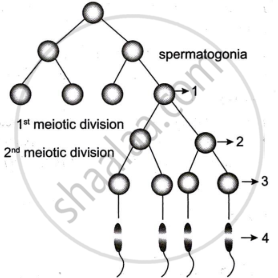Advertisements
Advertisements
प्रश्न
Describe the structure of the human ovum with a neat labelled diagram.
उत्तर
The human ovum is non-cleidoic, alecithal, and microscopic in nature. Its cytoplasm called ooplasm contains a large nucleus called the germinal vesicle. The ovum is surrounded by three coverings namely an inner thin transparent vitelline membrane, middle thick zona pellucida, and an outer thick coat of follicular cells called corona radiata. Between the vitelline membrane and zona pellucida is a narrow perivitelline space.

structure of the human ovum
संबंधित प्रश्न
Draw a sectional view of human ovary and label the different follicular stages, ovum and Corpus luteum.
Explain the development of a secondary oocyte (ovum) in a human female from the embryonic stage upto its ovulation. Name the hormones involved in this process.
Describe the process of oogenesis in human female.
What is gamete formation?
Give scientific reason.
Older women are more likely to give birth to children with some abnormalities.
Identify the labels (i-iv) in the given diagram of the ovum.

Identify the CORRECT sequence of events.
The immature male germ cells differentiates into ______ at the end of meiosis I.
Which of the following is diploid?
Which of the following events take place during spermatogenesis?
Corona radia is made up of ______.
Spermiation is the process of the release of sperms from ______.
The prostate gland and seminal vehicle perform the function of ______.
Aquatic animals in which fertilisation occurs in water are said to be
What does figure represent?

In human females, meiosis II is not completed until:
Process of maturation and development of sperms ______.
Explain Oogenesis with diagram.
Distinguish between human sperm and ovum.
The diagram given below shows the various steps in spermatogenesis.

- Name the parts labelled '1', '2' and '3'.
- Name the process by which part '3' changes to part '4'.
